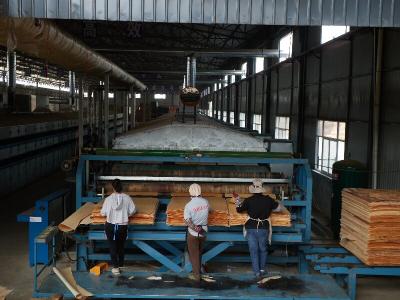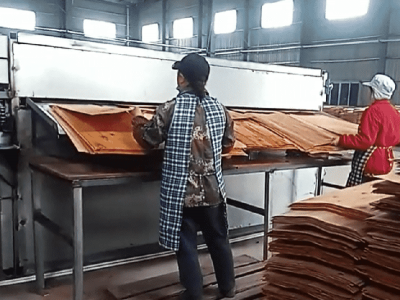What is the dehumidification working principle of veneer dryer?
Understanding the Core Drying Principle: Constant Enthalpy and Humidity Control
Before delving into the role of moisture-proof devices, it is critical to revisit the physics of veneer drying. As described in the provided context, the process unfolds as follows:
Heating Wet Air: Wet air (containing moisture from the veneer) is heated by external equipment under constant pressure. This heating does not add new moisture to the air but raises its temperature, causing the water vapor within it to expand.
Reducing Relative Humidity: By increasing the air temperature without altering its moisture content, the relative humidity (RH) of the air decreases. For example, air at 20°C with 10g/kg moisture content has an RH of ~65%; heating it to 30°C (same moisture content) lowers the RH to ~35%.
Isoenthalpic Drying: As the heated air enters the dryer, it absorbs moisture from the veneer. During this phase, the total enthalpy (energy) of the air remains nearly constant, but its temperature drops while its moisture content rises. This isenthalpic process ensures efficient moisture transfer from the veneer to the air, driving the drying cycle.

Advantages of Top-Mounted Moisture-Proof Devices in Veneer Drying
1. Enhanced Drying Consistency and Quality
The most critical advantage of moisture-proof devices lies in their ability to maintain a stable, low-RH environment inside the dryer. By blocking external humidity, these devices ensure that the air inside the dryer remains at the optimal RH (typically 30–50% for most veneers) throughout the drying cycle.
Uniform Moisture Removal: Stable RH prevents “humidity spikes” caused by external air infiltration, which can lead to uneven moisture distribution in the veneer. This uniformity is critical for avoiding defects like warping, cracking, or surface checking—common issues in poorly controlled drying processes.
Preservation of Veneer Integrity: For high-value veneers (e.g., those used in furniture or decorative panels), maintaining precise moisture levels during drying preserves the wood’s natural grain, color, and mechanical properties. Moisture-proof devices minimize the risk of thermal shock or over-drying, ensuring the veneer retains its structural and aesthetic value.
2. Reduced Energy Consumption
Heating wet air is energy-intensive, and any inefficiency in the drying process directly impacts operational costs. Top-mounted moisture-proof devices reduce energy waste by:
Minimizing Reheating Needs: External humid air entering the dryer has a higher moisture content than the target internal air. To compensate, the heating system must work harder to raise the RH of this incoming air, increasing energy consumption. By blocking infiltration, moisture-proof devices reduce the volume of humid air that needs heating, lowering energy use by 15–25% in real-world scenarios.
Optimizing Isoenthalpic Processes: The isenthalpic drying principle relies on maintaining a steady energy balance. Moisture-proof devices stabilize the internal environment, allowing the dryer’s heating system to operate at peak efficiency without constant adjustments to compensate for external humidity fluctuations.
3. Extended Equipment Lifespan
Moisture is the enemy of industrial equipment. High humidity inside or outside the dryer can lead to corrosion of metal components, mold growth on surfaces, and degradation of insulation materials—all of which shorten the dryer’s service life.
Preventing Condensation: When warm, moist air from the dryer comes into contact with cooler external air (e.g., through open doors), condensation forms on surfaces like the dryer’s roof, walls, or internal ducts. Over time, this moisture weakens structural components and promotes rust. Moisture-proof devices redirect internal moisture vapor upward (away from cold surfaces) and block external cold air infiltration, minimizing condensation risks.
Protecting Electrical Systems: Modern dryers rely on sensitive electrical controls (e.g., sensors, motors) that are vulnerable to moisture damage. By maintaining a dry internal environment, moisture-proof devices reduce the likelihood of short circuits, sensor malfunctions, or motor corrosion, extending the lifespan of these critical components.





